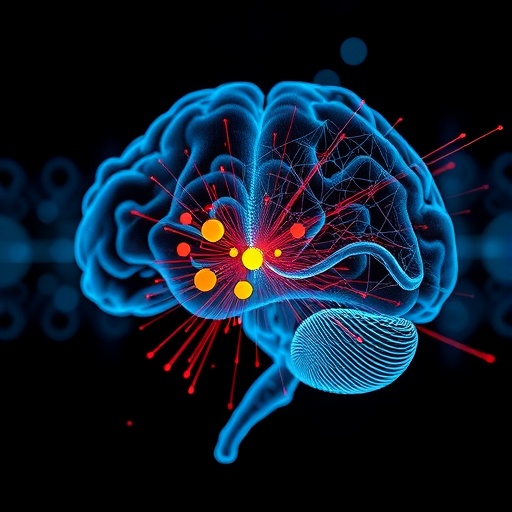In an era where medical imaging technologies are rapidly evolving, a groundbreaking study has emerged that highlights the promising future of magnetic particle imaging (MPI) as a diagnostic tool for brain diseases. Conducted by a team of researchers led by Guo et al., this research illuminates MPI’s potential, revealing its capacity not only to enhance diagnostic accuracy but also to provide insights into previously challenging medical conditions affecting the brain.
Magnetic particle imaging is a relatively nascent imaging modality that is gaining traction due to its high resolution and real-time imaging capabilities. Unlike traditional imaging techniques such as MRI and CT scans, MPI utilizes superparamagnetic nanoparticles as tracers, enabling it to visualize biological processes with exceptional clarity. The researchers embarked on this study with the hope of demonstrating how MPI could revolutionize the way neurologists diagnose and monitor various brain disorders.
The study meticulously details the technical underpinnings of MPI, explaining the unique properties of superparamagnetic nanoparticles that render them ideal for imaging applications. These nanoparticles can be manipulated using external magnetic fields, allowing for precise control over the imaging process. The researchers conducted a series of experiments illustrating the sophistication of MPI, highlighting its ability to provide high-resolution images that are not only detailed but can also be reconstructed in real-time.
Notably, one of the most compelling aspects of this research is its implications for diagnosing neurodegenerative diseases such as Alzheimer’s and Parkinson’s disease. Current diagnostic methods often fall short in terms of sensitivity and specificity, leading to difficulties in early detection. MPI presents a solution by allowing for the visualization of pathophysiological changes at a cellular level, offering the potential for earlier and more reliable diagnosis of these debilitating conditions.
The researchers explored the versatility of MPI in various neurological applications. For instance, the study discusses how MPI can be employed to assess brain tumors, providing invaluable information regarding tumor size, location, and vascularity. This enhanced capability could significantly impact patient management and treatment planning, allowing clinicians to tailor therapies based on accurate imaging data.
One of the study’s key findings is the favorable contrast-to-noise ratio that MPI offers compared to other imaging modalities. This characteristic is particularly important in neuroimaging, where clarity and detail can influence clinical decisions. The researchers illustrated this by comparing MPI images to those obtained from conventional methods, showcasing the superior imaging quality achieved through MPI’s innovative technology.
Moreover, the study delves into the challenges associated with implementing MPI for clinical use. While the technology shows incredible promise, several hurdles must be overcome before it can become a mainstream diagnostic tool. These challenges include the need for regulatory approval, standardization of imaging protocols, and ensuring the safety and biocompatibility of the superparamagnetic nanoparticles used in the imaging process.
Collaboration between scientists, clinicians, and regulatory bodies is essential to address these challenges and expedite the transition of MPI from experimental settings to clinical practice. The study emphasizes the importance of interdisciplinary teamwork in medical research, as advancements in technology often require a synergy of expertise from various fields to ensure successful implementation.
As the study concludes, it paints an optimistic picture for the future of magnetic particle imaging in neurology. The potential for MPI to transform diagnostic pathways for brain diseases is immense, especially as ongoing research efforts continue to refine and optimize this innovative imaging technique. Should the regulatory and practical challenges be narrowly defined and addressed, MPI could soon become a staple in the diagnostic arsenal against brain disorders.
Looking ahead, the researchers urge fellow scientists and healthcare practitioners to explore the possibilities offered by MPI. They encourage further investigations and clinical trials to better understand the technology’s capabilities, aiming to establish protocols that can seamlessly integrate MPI into routine clinical practice. In doing so, they envision a future where patients benefit from earlier diagnoses and improved treatment outcomes as a result of advancements in imaging technology.
With this groundwork laid by Guo et al., magnetic particle imaging could herald a new era in neuroimaging. The study serves as a clarion call for innovation and collaboration in the field, inspiring the next generation of researchers to continue exploring the vast potential of MPI and other emerging technologies to enhance patient care.
Undeniably, the findings of this research have far-reaching implications, not only for the fields of neurology and medical imaging but also for the broader medical community. As technology continues to evolve, the hope is that MPI can contribute to a deeper understanding of brain diseases, ultimately leading to the development of novel therapeutic interventions.
In conclusion, the exploration of magnetic particle imaging illustrates a tangible advancement in diagnostic medicine that could reshape how we approach brain health. The groundbreaking work by Guo, An, Zhang, and their colleagues exemplifies the relentless pursuit of knowledge that drives the scientific community forward, painting a hopeful picture for what lies ahead in the realm of medical imaging.
Subject of Research: Magnetic Particle Imaging for Brain Diseases
Article Title: Exploring the diagnostic potential: magnetic particle imaging for brain diseases
Article References:
Guo, LS., An, Y., Zhang, ZY. et al. Exploring the diagnostic potential: magnetic particle imaging for brain diseases. Military Med Res 12, 18 (2025). https://doi.org/10.1186/s40779-025-00603-5
Image Credits: AI Generated
DOI: 10.1186/s40779-025-00603-5
Keywords: Magnetic Particle Imaging, Brain Diseases, Neurology, Medical Imaging, Superparamagnetic Nanoparticles, Neurodegenerative Diseases, Diagnostic Tool
Tags: brain disease diagnosis advancementsfuture of brain disease diagnosticshigh-resolution medical imaginginnovative diagnostic tools for neurologyMagnetic particle imaging technologyMPI compared to traditional imagingMPI research breakthroughsneurological disorder monitoringprecision imaging in medicinereal-time brain imaging techniquesrevolutionary imaging modalitiessuperparamagnetic nanoparticles in imaging





